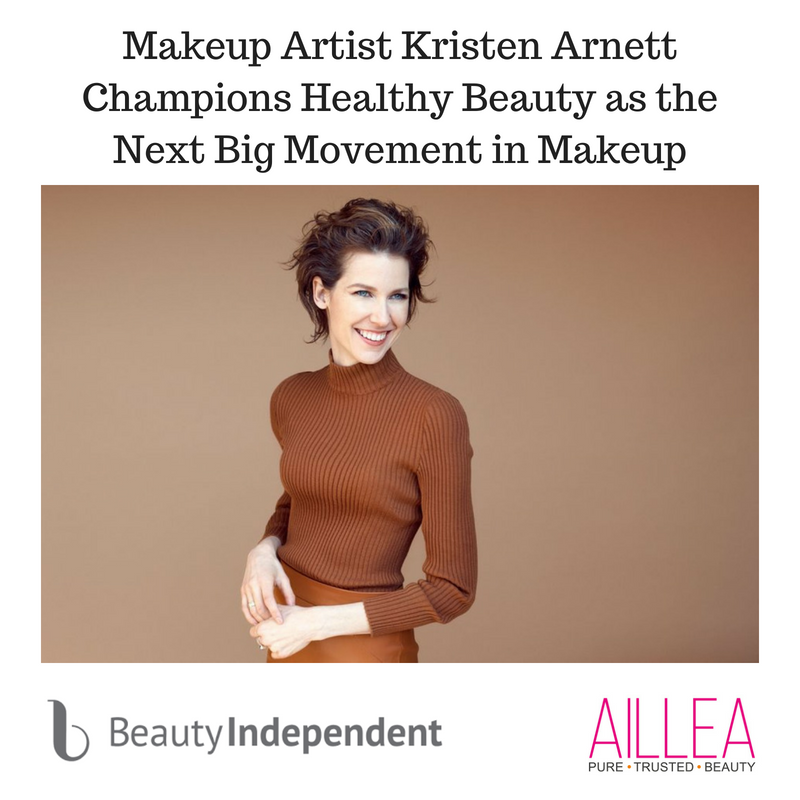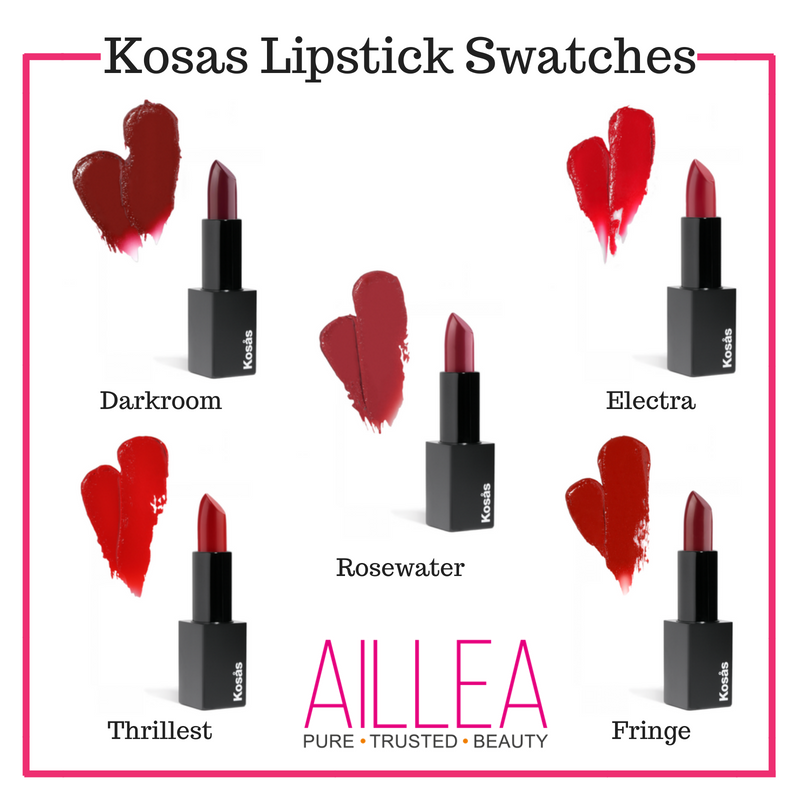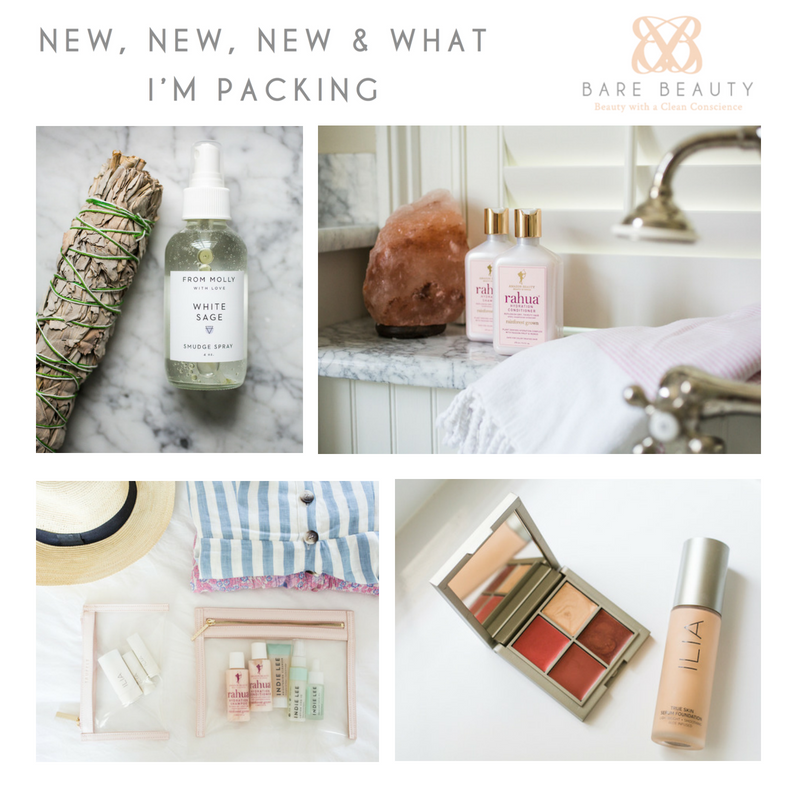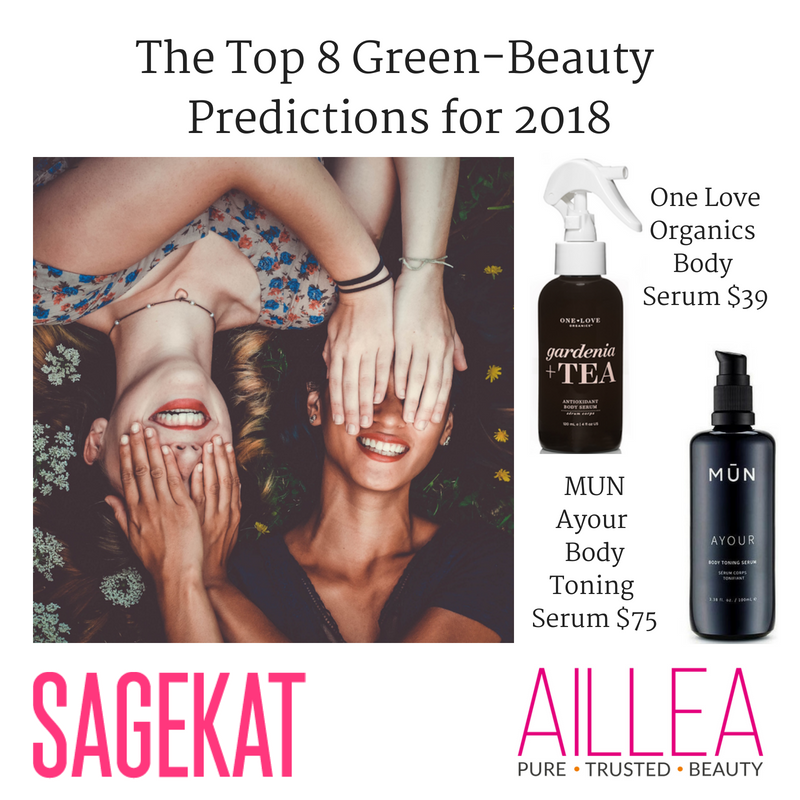
After perfecting her beauty skills on the runaway, Kristen Arnett is turning her focus to real people. The pioneering ingredient-conscious makeup artist has stepped away from fashion weeks to deliver educational content worldwide. Arnett is particularly interested in catering to women aged 40-years-old and older, who she views as underserved in the beauty industry - and beyond. "So many of my clients tell me, 'I feel like I'm 24, but my face doesn't reflect that. How can we make those two come closer together?' That's the hallmark of my work now," she says. "I can teach people tricks on how to get there better and quicker than they were before, but I want to know, at the end of the day, do you feel beautiful as a woman? That doesn't have to do with the makeup you put on, but it's about experiencing inner love and honoring yourself." Arnett talked to Beauty Independent about spreading the love, collaborating with retailer Aillea on a beauty box, the unglamorous side of fashion shows, fruitful brand partnerships, digital strategy, the concept of healthy beauty and long-term goals.
How did you get into beauty to begin with?
It was a passion since I was young, and it developed out of seeing makeovers on television. I was just fascinated by that, and I would cut out the heads [of the models] in my mom’s fashion magazines for the faces. This was pre-Instagram and pre-YouTube. I had only magazines and a bit of television for inspiration. My mom was a little concerned when I cut the heads out of magazines, but she was very encouraging. I went to school for business, and did cosmetic color development and marketing at Merle Norman in Los Angeles. I sold Merle Norman cosmetics in college. That was a really valuable experience, and the bug to do makeup as a profession bit me hard. By the time I was 27, I couldn’t ignore it anymore.
You moved to Milan to pursue a career as a makeup artist. What was that like?
I was lucky enough to get a mentor, and he really helped me get unpaid test work. Test work means everyone on the shoot is unpaid. I was living off savings from selling half my things. I would come back to the U.S., work like crazy doing weddings, and get enough cash to go back to Italy and live off almost nothing. I worked really hard to build my portfolio, get representation and learn Italian. I finally got an agency there who didn’t represent me, but they were willing to send me out for work, and I got onto runway shows. My first runway show was Armani with Charlotte Tilbury. That was the beginning of my runway career.
You recently decided to retire from fashion shows. Why?
On the one hand, it’s the coolest thing ever and, on the other hand, it’s the worst thing ever. When I was doing the full circuit, it wasn’t fashion week. It was fashion month. You travel with the hairstylists, models and makeup artists, and you’re all passing around illnesses. You’re on a plane with strep throat and, when you land, you have very little time to acclimate before your first call time. You have to take public transportation to transport all your materials. In February in New York, it’s the worst weather, and I’d be pushing my makeup kit and my body against zero degree winds. That’s less glamorous at the age of 40 than when you are younger and the recovery is easier.
In Paris, the truth is – and a lot of people don’t talk about this, but I’m willing to – you’re not getting paid that much money as an artist. We share an Airbnb flat [and sleep] on air mattresses because it’s expensive to stay and eat in Paris. When you’re at the shows, the food there isn’t nourishing. It can be a rough. At 40, I figured I was done crawling on my hands and knees putting makeup on girls’ legs, which you have to do after you are done with their faces. I’d had enough.
How were you introduced to green beauty?
The first person to turn me on to green beauty was May Lindstrom. She was a model, and I was a makeup artist. That’s how we met. She was the reason I ever considered what’s in products. She said, “You have to meet Rose-Marie Swift in New York. She has a line, and you should check it out.” I was nervous to meet her, but that started a friendship with Rose-Marie that’s been going on 10 years.
Why did green beauty appeal to you?
There wasn’t that term back then. It was a completely new concept. It wasn’t presented to me as an established concept. I was told about things in products you put on your skin that could be bad for your health. What I was seeing was that, at runway shows, the models could no longer tolerate the brands we were all using. They were having severe reactions to the makeup. That really started to impact me.
Plus, I had acne for 10 years and had done all of this stuff to try to do something about it. May, who I saw at the time covering herself in olive oil, said to me, “Stop attacking your skin and see what happens.” And I did. I stopped attacking my skin, and starting using olive oil and other natural things. I started to look really amazing. It seemed like a really reasonable approach to skin, and I wanted to make it work professionally.
How did you make it work professionally?
There were very, very, very few products to choose from, and I reached out to the few brands that existed at that time in early 2009. Rose-Marie and Jane Iredale were the only ones doing it in a big way – and Rose-Marie wasn’t big at the time. People thought she was totally weird, and thank God for that. She was doing something no one else was doing.
It was tricky because I had to learn how to work with those products on set with the requirements that as a makeup artist I had for texture, performance and functionality. I couldn’t just put on tinted lip conditioner and call it a day. I needed stuff that worked. I started adding more brands as they came out, and I would weed things out. There have been many brands along the way that were generous and saw the vision. There is no way to track how many sales I’ve made as a makeup artist [for brands as a result of] using their products, but I will tell you that every single person who saw my kit was totally fascinated because it was so different.
What’s your makeup style?
I’m definitely known for the less-is-more philosophy. There are times when I want to do something really over-the-top theatrical and avant garde, but my go-to is not to cover up someone. I like to enhance what’s there. I don’t paint roller over them and utilize them as a 3D sculpture.
How do you evaluate brands today?
I’m not interested in working with anyone that’s just in this for profiting off of an industry that’s growing really fast. I’m interested in brands that are truly willing to have a conversation with me about who they are, their ingredients and their ethics. I want to work with people who are in it for the right reasons. Then, when a brand and I are jiving, I ask them to send me a sampling of their whole line, which is a big investment for them, and I know that. As an artist, I need many things to play with, and I try them for a long time. I use them on myself and on shoots. That’s how I fall in love with things. When I do, I become a megaphone for a brand or product.
What partnerships have been particularly successful?
Playing the role of art director, makeup artist and hairstylist using exclusively natural products for a Coco Eco magazine shoot was amazing because it stretched me to the max, and I loved it 100%. It was a real coup to be named the Italian national trainer for the launch of Burberry Beauty because of my retail background, artistry skills, and fluency in Italian to train their entire retail force. I enjoyed working with [Karlie Kloss] tremendously on numerous occasions. Doing makeup for so many top models and celebrities over the years has been a true privilege, and something I only dreamed of when I was just starting out. Celebrity or not, what’s more powerful than anything is every time one of my clients hold back tears or beams with joy when she sees herself in a new way that she loves.
I do so much due diligence at the beginning of working with a brand, and I’ve loved ones I’ve worked with, including Hynt Beauty, Innersense Organics, W3ll People, Elique Organics and Sappho. I’m willing to work with brands if they value me, and I value them. It can be for sponsored content, a social media shoot, a limited-edition product collection or putting their products in my kit. Everything that’s in my kit gets shared with my clients.
What don’t small brands get about working with a makeup artist?
It’s a tricky landscape these days. Makeup artists used to be the influencers. It’s not a fast-and-furious social media model, so you don’t see your ROI instantly, and you may not even have metrics. A makeup artist is a very different thing from a professional blogger, and you can’t expect them to run their social media or their website the same way. The fact that I do both is a lot of work. That’s why I’ve stepped back from doing makeup full-time at this point in my career. I want to focus on educating people as many people as possible, and I can’t do that when I’m on a set for 12 hours.
How did you come together with Aillea for the Green Beauty Icon Experience, a box with seven staple natural beauty products?
Kathryn Murray Dickinson, the owner of Aillea, has really high standards and a clear vision. She’s one that people don’t see coming, but she has a solid beauty industry background, and she’s opening stores. The woman is smart and really kind, and that’s who I want to work with. I was just chatting with her about things. It was casual and a lightbulb went off for us. Within a week, we got the wheels in motion on a collection.
We didn’t even know there’d be a particular theme. It was just something I noodled around. She let me have space to offer my ideas and really honored my creative process. There are so many brands, and they are really wonderful, but I wanted to go back to who was there from the beginning when it wasn’t cool to be green. These are the people who started everything. They’ve invested insane amounts of hours and money not just in their brands, but in educating consumers so the entire industry would benefit. That’s why these people are icons.
What’s your digital strategy?
As of this month, everything is changing. I involved a bunch of contributors in skincare, haircare and nutrition on content, and that’s why I called the site Green Beauty Team. I wanted it to be more than one person’s perspective. There wasn’t any advertising because I wanted to make sure it didn’t have bias. As I grew in the world of blogging, it turned out I was doing much of the work myself. I’ve revamped kristenarnett.com, and it’s no longer just a place of my professional achievements and portfolio to get work. It’s becoming a destination for my healthy beauty values.
I’ve spent a long time talking about green beauty. Now, I’m on to the term healthy beauty. It’s looking at the totality of how we approach ourselves when we get in front of the mirror. I don’t care if you are using the best natural products, if all you are spewing at yourself in the mirror is hate, they’re not going to do any good. As women, we are told we have to be perfect whether it’s in business, the mom thing, cooking or exercising. There is so much pressure. No wonder anxiety disorders and panic attacks are increasing. I am looking forward to shifting from an ingredient focus to a focus on how we can feel better and treat ourselves like we really matter. To me, that’s healthy beauty.
What are the drivers of your business today?
I’m reinventing that as we speak. Some of the ways are paid premium experiences, beauty collections, select sponsored partnerships and the typical blogger stuff like affiliate sales when they make sense. If I would naturally recommend a product and there’s an affiliate opportunity, cool. If there isn’t, that doesn’t stop me from recommending a product. My virtual lessons are taking off big time. People love that they can access me from all over the world. I have online courses people can take. They can go through them as a self-study, and I do live workshops online. I’ve had people tuning in from Japan, Brazil and Canada.
Can emerging brands make inroads on runways?
With a lot of money, yes. Runway is all about numbers. What the designers are looking for is sponsors, and you’re competing against Maybelline, MAC and companies like that with enormous budgets. As a small brand, you can target independent designers. That’s not a bad place to start, but you want to make sure that the quality is there, and the way things are represented is right for your brand.
You are interested in concentrating on women 40-years-old and older. Why are you so interested in that demographic?
I feel like the over-40 community is so hungry for information, and there is a lot of makeup artists who have no idea how to do a mature face because, in fashion, you work with girls who are 15-, 16-years-old, and a lot of makeup artists started their careers working on themselves and their friends when they were young.
As women, we want to take care of ourselves, and we don’t want to be shamed that the age that we are is somehow wrong, which is why I will never use the term anti-aging. I say age-defying, which is not a perfect term. I’m pro-aging because that means continuing to live and taking care of yourself. What customers are looking to do is to gracefully age and look their best at every age. You want to look great where you are at. You can’t reverse time, although you also don’t want time to speed up.
Where do you envision yourself in the next five years?
I see almost a tribal community that’s created where women support their beauty in conscious and healthy ways through what I’m teaching. It’s a gathering of likeminded women who are on a journey. It’s about empowerment. I want to be a touchpoint for women to be real and honest, hang out and be treated without any shame for how they look. I want to touch people globally, and I’m already doing that. My website is very well-trafficked, and I have generous mailing list. I can only see that mushrooming. If we give people the tools to take care of themselves and we don’t promote fear, it can be life-changing and important.
What changes would you like to see in the beauty industry?
I would really love it if there were overarching standards for products in the U.S. I talk a lot about greenwashing. Companies can say something, but most customers won’t turn around the package to see if it’s true or, even if they do, they may not know how to interpret what they see. I hope that brands are as ethical as possible and live up to high standards even when standards aren’t placed on them. Ultimately, if companies don’t, they will lose the trust of the consumer, and it will backfire on them.
CLICK HERE TO READ FULL ARTICLE




